
In this tutorial I’m going to show you how to create perfectly striped frosting in bright Halloween colours and how to create these elegant gold pumpkins with buttercream! If you prefer to watch a video of this tutorial, scroll to the bottom of the page.
To make the striped frosting you’ll need a crumb coated cake that’s either at room temperature or chilled in the fridge. Spread a thick layer of frosting all over the cake

The colour you choose will be the colour that’s in between every other colour of stripes, so for me this is black and it means my stripes with be black, orange, black, purple, black, green… so black will be the main colour of the cake. I’m using my black buttercream that won’t stain your teeth.

Scrape around the frosting with a frosting smoother, making sure you have straight sides and spread more buttercream over any air pockets in the frosting to fill them in and then scrape again with your frosting smoother.

The frosting doesn’t need to be perfect but the neater it is, the fewer touch ups you’ll need to do later and it’s easier to do touch ups on smooth frosting than on striped frosting. If your cake is sliding around on the

Now use a striped cake comb and rest the bottom of the comb down on the cake board to line it up straight against the side of the cake, then press it gently into the frosting and hold it still while you spin the

Do this a few times and then spread more buttercream over any air pockets you can see in the stripes. If you don’t fill these holes in with black buttercream now, then later when you add the other colours, those colours will get into the holes and you’ll get splotches of green or orange or purple within your black stripes.

Scrape around again with your striped cake comb to smooth the stripes and you can repeat this process of spreading buttercream over air pockets and then smoothing again and again until the black stripes on your cake are fairly smooth.

The stripes don’t need to be perfect because you’re going to scrape the outer layer of frosting off later, but you don’t want any air pockets in the middle of the stripes. It’s important that the edges of the stripes are smooth so that you’ll have neat divisions between the colours. If there are air pockets along the edges of the stripes you’ll have blurry edges on your stripes.

Tidy up the top edge by pushing any frosting sticking up over the top edge of the cake, over into the middle of the cake using your

If your top stripe is really thin, like mine is here, it’s difficult to get it neat so if you like you can just scrape off that top stripe with your frosting smoother and then tidy up the top edge. Put the cake in the fridge for 30 minutes or the freezer for 15 minutes and set a timer and I’ll explain why in a minute.

Meanwhile, make the colours for the rest of your stripes. To make really bright, almost neon colours, start with your basic colour like orange or green and then add a brightener, which for orange and green is yellow. You can see how bright these colours become! I go into this in much more detail in my online course on the Basics of Buttercream.

To add the coloured stripes to your cake you’ll need three piping bags, or however many colours you’re using for the stripes. Cut the tips off the piping bags so that they’re about as wide as the stripe grooves you imprinted into the frosting with your cake comb. Put a colour of buttercream in each bag.
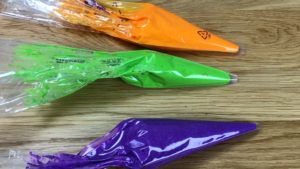
Take your cake out of the fridge or freezer when your timer goes off and the frosting will be just cold enough so that the black stripes hold their shape and don’t squish into the stripe grooves to blend with the other colours. If you touch it, you shouldn’t be able to indent it with light pressure from your finger.

Pipe your coloured buttercream into the grooves, making sure you push the buttercream all the way into the grooves and that the colours go up to the edges of the grooves, otherwise you’ll get air pockets when you smooth the frosting.

Don’t worry if you pipe the colours over the top of the black stripes because they’ll scrape off easily in the next step. When you’ve filled in all of the grooves with colours, use you frosting smoother to scrape around the cake just like you would if you were doing smooth frosting.

You’ll scrape off some of the colours but also smear them all over the sides of the cake and that’s fine! The frosting that comes off on your frosting smoother will be all of the colours that you piped into the grooves, because you’re just taking off all of the excess right now.

Wipe any buttercream off from your frosting smoother into a bowl and scrape again. Although the cake looks messy, with coloured frosting smeared all over it and nothing that resembles stripes, don’t worry! Trust the process. With each scrape you’ll take off more of the excess of coloured buttercream.

Then you’ll start taking off the top layer of the black frosting too, so you’ll see all of the colours of buttercream come off on your frosting smoother with each scrape. At this point your frosting will be fairly smooth, and your stripes will begin to look neater.

You’ll probably have some gaps or air pockets in your frosting where the stripe grooves weren’t completely filled in with the other colours of buttercream. Fill those holes in by spreading one some more of that colour of buttercream and don’t worry if this colour spread over the surrounding stripe colours because you’re going to scrape all of that off and just leave the buttercream that’s filling in the hole.

Scrape around with your frosting smoother, and now the frosting that comes off on your frosting smoother should be in even stripes like the ones on your cake!

The reason for setting the timer when you put the cake into the fridge or freezer after using the striped cake comb on the first colour of frosting, is to make sure your frosting doesn’t get too cold.

If it’s very cold and hard, it will be difficult to smooth now and instead of coming off easily with the other colours you’ve just piped, making the frosting smoother with each scrape and also making the stripes neater and more defined, if the frosting is too cold you’ll struggle to scrape off that top layer and you’ll leave jagged texture in the cold frosting.

When you’re happy with your stripes you can either tidy up the top edge as normal, or you can put the cake back in the fridge or freezer for about 30 minutes to set the frosting and then use a sharp knife to trim around the top edge of the cake to take that excess frosting off from around the top and leave a nice sharp angle around the top edge.
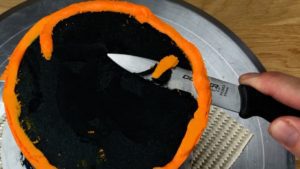
When the cake is cold, wipe around the cake board with a paper towel to take off any smudges of frosting and now we’re going to make this cake even more Halloweeny!

To make some elegant gold pumpkins you’ll need two piping bags of buttercream, one fitted with a 1M star tip and the other with a smaller open star tip like this #199. I use my 4 Minute Buttercream because it sets firm when it’s cold, which makes it possible to turn it gold later.

Spread out a piece of parchment or wax paper big enough to fit however many pumpkins you’ll need for your cake, plus an extra one to be safe! Use the piping bag with the smaller piping tip to pipe a stem, starting at the top of the stem because where you start is the neatest part, and the top is the part that will be visible at the end.

Switch to your 1M tip to pipe the pumpkin, piping two curved lines for the middle and two more curved lines around the outside, always piping from the top down because where you start piping is the neatest and we’re not going to see the messier parts at the bottom when we’re finished.

The beauty of piping these onto paper instead of straight onto the cake is two-fold. Firstly, it’s easier to pipe downwards that onto the side of a cake, so your lines will be smoother and neater this way.
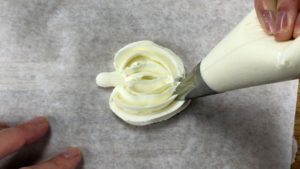
But also, you can practice and experiment as much as you like until you’ve made enough pumpkins that you’re happy with, and use only those on your cake. You can scrape any ugly pumpkins off the paper and put the buttercream back in your bowl to re-use for something else.

Slide a cutting board or baking tray under the paper and put them in the freezer for at least an hour to set. Just before you take them out, make some gold paint using gust luster dust and a few drops of clear alcohol like vodka, or this is almond extract and any clear coloured, alcohol based flavor extract will work.

You want a fairly thick paste to get a strong golden colour. If you add too much liquid, it will evaporate and the paint will get thicker or you can add a bit more powder to thicken it up straight away. Take your pumpkins out of the freezer and brush them with the gold paint.

A large paintbrush will be quicker but it’s useful to have a fairly small tip to be able to get into all of the creases within the piping, so if you like you can use two different brushes for this.

Spin the paper around to check the pumpkin from different angles to make sure you’ve covered all of the buttercream with gold paint but don’t worry about the very bottom of the pumpkin because that’s going to be pressed down on the cake board so you won’t see it.

If you notice the buttercream getting soft while you’re painting, and the paintbrush is sticking to the pumpkins or texturing them as you paint, put them back in the freezer for a few minutes.
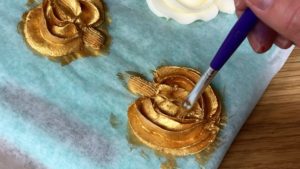
When you’ve painted all of your pumpkins, save your leftover paint for later. Put the pumpkins into the freezer for about an hour so that the gold paint dries and so that the buttercream firms up again, because it will have warmed up and softened while you paint.

Now pipe or spread a bit of buttercream onto the frosting on your cake wherever you want to place a pumpkin. The buttercream will act as glue to attach the pumpkin to the frosting on the cake, which has set and is no longer sticky.

Lift a pumpkin up with your

After you’ve arranged your pumpkins, wrap a strip of parchment or wax paper around them and press gently to curve the pumpkins to wrap them more tightly around the cake. They will have softened a bit at room temperature so they should curve easily but if they crack, don’t worry, we’re about to touch them up.
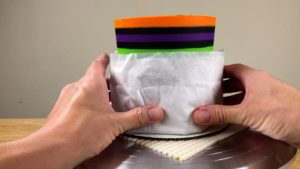
Add a drop of alcohol or extract to your leftover gold paint if it’s dried up and paint any areas of the pumpkins where the white buttercream is showing through, where you pressed them onto the cake and wiped off the gold paint.

If the pumpkins have cracked anywhere, paint over the cracks and you’ll disguise them. You can use your paintbrush to manipulate the buttercream too, pushing sections of piping back towards the cake if they’re still sticking out.

I’m piping some swirls of buttercream onto top of the cake using a 1M star tip and I’m using a clock method to space them equally around the cake. To do this, pipe the first two swirls opposite each other at 12 o’clock and 6 o’clock and then the next two at 3 o’clock and 9 o’clock.

Look at the other swirls as you pipe to make sure you finish each one at the same height. Then adding another swirl in the gaps in between those swirls. For each swirl, aim to get right up to the edge of the cake without piping over the edge.

As a finishing touch I’m pressing a few sprinkles into the frosting, and although the frosting has set because I chilled it to make the stripes, with just a little bit of pressure I can push the sprinkles into the frosting and they’ll stick.

And there it is! A colorful cake with elegant gold pumpkins, all made with buttercream frosting! If you make this cake, please tag @britishgirlbakes in your photos on instagram so I can see your version! If you’re looking for more ideas, check out my tutorial on 20 Ways to Decorate Gold Cakes.

Here’s the video version of this tutorial:
